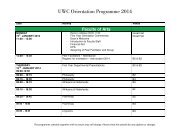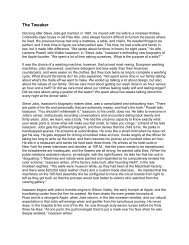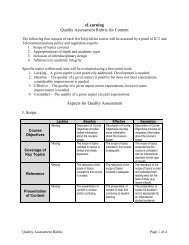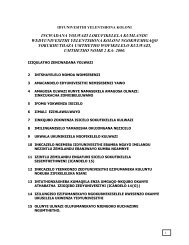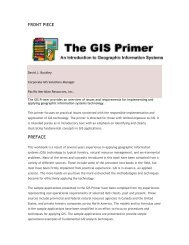Ecosystem Guidelines for Environmental Assessment
Ecosystem Guidelines for Environmental Assessment
Ecosystem Guidelines for Environmental Assessment
Create successful ePaper yourself
Turn your PDF publications into a flip-book with our unique Google optimized e-Paper software.
COASTAL<br />
What are the “bottom lines” and non-negotiables<br />
No development should be allowed in sand movement corridors, frontal dunes or dynamic dune<br />
systems. Developments should be placed inland of secondary dunes.<br />
Mobile dunes must not be stabilised.<br />
Strict control should be maintained over the use of Off-road Vehicles (ORVs) on beaches. There must<br />
be a strictly en<strong>for</strong>ced ban (that includes management vehicles) against driving in dune systems and<br />
above the high water mark on beaches. Access to the beach must be controlled via designated access<br />
points.<br />
Provision should be made <strong>for</strong> rehabilitation of mined-out areas when mining ceases, and of<br />
historically mined areas.<br />
What broad spatial guidelines can be given with respect to<br />
the best approach to development and disturbance<br />
Infrastructure must be positioned to avoid damage from coastal processes and, where possible, to<br />
avoid the need <strong>for</strong> physical defences against potential damage resulting from coastal processes.<br />
No permanent infrastructure should be installed on sandy beaches and in dynamic or mobile dune<br />
systems.<br />
Development setback lines must be rigorously applied, taking into account the need to protect<br />
development from coastal processes by: absorption of the impacts of severe storm sequences; allowing<br />
<strong>for</strong> shoreline movement; allowing <strong>for</strong> global sea level rise; allowing <strong>for</strong> the fluctuation of natural coastal<br />
processes; and any combination of the above. 1<br />
Development setbacks must also take into account biodiversity and ecosystem requirements<br />
(especially in Dune Thicket systems), landscape, seascape, visual amenity, indigenous and cultural<br />
heritage, public access, recreation, and safety to lives and property (consult the guideline on Dune<br />
Thicket and Dune Fynbos p.32).<br />
Avoid the removal and fragmentation of indigenous vegetation in the frontal dune area. Maintain a<br />
buffer of contiguous indigenous vegetation between the inland boundary of the youngest fixed dune<br />
trough and the seaward boundary of the<br />
development (the exact setback will depend Certain bathing beaches may eventually disappear if sand<br />
movement via headland by-pass dunes is impeded by property<br />
on the biophysical characteristics and<br />
development and infestation by alien plants.<br />
requirements of the area, and the type and<br />
scale of development) 2 .<br />
There must be rigorous adherence to the<br />
precautionary principle when constructing<br />
fixed infrastructure below the high water<br />
mark.<br />
Driving on sandy beaches above the high<br />
water mark or in dune systems must be prohibited.<br />
The ban on driving should also be maintained<br />
at popular bathing beaches, on<br />
beaches that support important shorebird<br />
breeding, feeding or roosting sites, and in the<br />
coastal zone of coastal protected areas<br />
except on proclaimed roads.<br />
BOTANICAL SOCIETY OF SOUTH AFRICA<br />
30 : SANDY BEACHES & DUNE SYSTEMS 1. Western Australian Planning Commission (2003) Statement of Planning Policy No 2.6 - State Coastal<br />
Planning Policy. Prepared under Section 5AA of the Town Planning and Development Act 1928.<br />
2. Council <strong>for</strong> the Environment (1991) A policy <strong>for</strong> coastal zone management in the Republic of South<br />
Africa, Part 2: <strong>Guidelines</strong> <strong>for</strong> coastal land-use. Council <strong>for</strong> the Environment, Pretoria.



